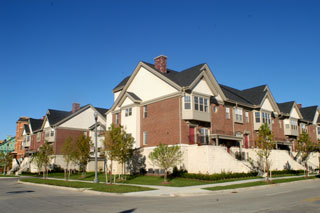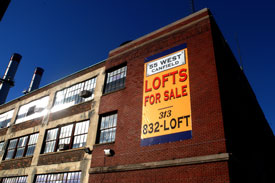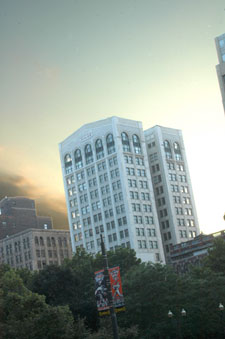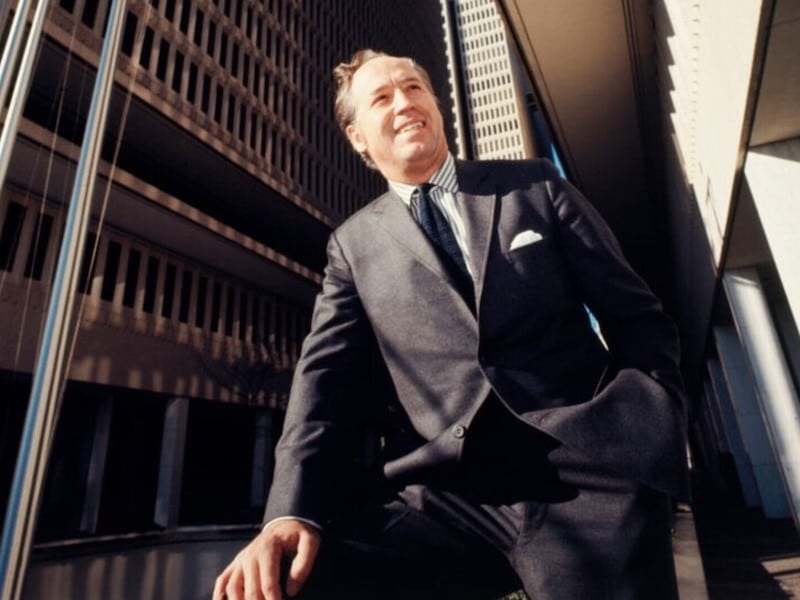Motor City Gold Rush
It reads like something out of an old Western. The first settlers were familiar with the land, but once they struck gold, so to speak, with Detroit development, out-of-state pioneers came in and staked their claims. From Miami, New York, Chicago and Indianapolis, they’ve come to the Motor City with cash to invest and visions of profits as they build condos, lofts and apartments in a market ever ripening for redevelopment.
As the city witnesses for the first time in decades pockets of inner-city development and yuppies in lofty condos from Downtown to Wayne State University, from Michigan Avenue to East Jefferson, one wonders, who’s doing all this construction, and why now?
After a few trailblazing local developers took the plunge in the late 1990s, building and selling Downtown condos and apartments for $150,000 to $350,000 — and selling out a handful of projects like hot cakes on a cold day — developers, investors and bankers began to see there is a demand for new and market-rate housing in Detroit, says Peter Zeiler of the Detroit Economic Growth Corp., a nonprofit that administers city tax breaks and incentives to encourage economic activity in Detroit.
Moreover, investors saw there was money to be made. And surprisingly, it’s been developers from other parts of the country — Miami, New York, California, Cleveland, Indianapolis, Chicago — who are taking a bite on the Motor City while suburban developers, for the most part, are sitting back and watching, Zeiler says.
For instance, a developer from Irvine, Calif., has bought the New Center’s Argonaut Building for a residential project and a Florida developer has announced a luxury condo plan for the 14-story Lafayette Building near Campus Martius Park.
“With a handful of exceptions, local developers are ignoring Detroit and letting the out-of-state developers come and eat their lunch,” Zeiler says. “It’s interesting that suburban developers have largely ignored Downtown.”
 Of course, there are notable exceptions. Zeiler credits Crosswinds Communities of Novi as a “major savior” of Detroit. By building upscale town homes in Brush Park, facing Woodward and near Comerica Park and Ford Field, and then promptly selling the properties and expanding the project, Crosswinds created a high-profile catalyst for Downtown’s development resurgence.
Of course, there are notable exceptions. Zeiler credits Crosswinds Communities of Novi as a “major savior” of Detroit. By building upscale town homes in Brush Park, facing Woodward and near Comerica Park and Ford Field, and then promptly selling the properties and expanding the project, Crosswinds created a high-profile catalyst for Downtown’s development resurgence.
“You don’t get more visible than the Brush Park project,” Zeiler says.
Builders as the Hubbell and Farbman groups, as well as the Schostak Bros. and the Garrison Co., also have played a major role.
In the last five years, new development has brought some 3,000 new residents to Downtown, Midtown and Jefferson East — and in the next five years, the area around Wayne State University alone will see a double in the number of new units available, Zeiler says. The number of developers working in Midtown has risen from about 5 to somewhere around 50, he says.
“For years, new product was not being put on the market place. Lenders and builders were so conservative that they thought there was no way you could build something and make money. You had to go outside of Detroit to get new product. The overwhelming success of a couple of pioneers has provided incentive for people to look at Detroit.
We’ve seen a complete change in the market of Detroit. Bankers and constructors finally get it, and it’s really opened up the tap,” Zeiler says.
The Gold Rush
The early demand for new condos and apartments was so high it shocked developers, they say. The Hubbell Group surprised many onlookers and neighborhood residents in 1999 when they turned a former warehouse near Wayne State into modern lofts for sale starting at $170,000. The 35 lofts sold out in nine months.
“I have a suburban condo development. If we have eight people coming through in a weekend, we’re happy. Downtown, we’ll have 30 to 40 during the same time. And suburban projects you have to spend thousands on marketing and advertising,” says J.C. Cataldo of the Hubbell Group. “The Downtown market has turned the corner. Not only is there interest, but there are buyers.
 “When we did the Canfield lofts, the first day we opened the doors 200 people showed up to look at floor plans. We looked at each other and said, ‘Holy cow,’” Cataldo says. He had to hire extra staff because thousands of people were looking at the units. “Up to then, I had every naysayer saying, ‘You’re nuts. Nobody wants to live Downtown.’ That was untrue. The reason people didn’t live Downtown is because there weren’t any options.”
“When we did the Canfield lofts, the first day we opened the doors 200 people showed up to look at floor plans. We looked at each other and said, ‘Holy cow,’” Cataldo says. He had to hire extra staff because thousands of people were looking at the units. “Up to then, I had every naysayer saying, ‘You’re nuts. Nobody wants to live Downtown.’ That was untrue. The reason people didn’t live Downtown is because there weren’t any options.”
He says there are still areas, like the Wayne State neighborhoods, that have pent-up demand. There are few housing options around the school “that a parent would consider putting their children into,” he says. “There’s a lot of opportunity there.”
For the Hubbell Group’s next project, 30 lofts at 55 W. Canfield, the first 10 units sold in 20 days, Cataldo says.
 “We get calls daily, wanting to know when the rest will be released. The interest is very deep,” Cataldo says. “If you build, they will come.”
“We get calls daily, wanting to know when the rest will be released. The interest is very deep,” Cataldo says. “If you build, they will come.”
They — the buyers — have certainly arrived, but so have other developers. Just three years ago, there wasn’t much competition among developers for city projects or buyers’ attention. There still may not be much compared to other major metropolitan areas, but the competition on both fronts is heating up.
“We’re seeing a shift in the market,” Zeiler says. “Three years ago, anything built was grabbed immediately. What we’re seeing now is that developers have to be more competitive with each other in terms of price, quality and amenities. The market has become more discerning.”
Cracking the Detroit market
But not everyone recognizes the heat emanating from the Downtown market — there’s still a pioneer spirit to development there.
“When you go other places and say you are working in Detroit, people look at you funny. Detroit doesn’t have the highest regard in the country,” says Bob Bates of Mansur Real Estate Services in Indianapolis.
 Bates, along with a suburban Detroit developer, converted the Kales Building Downtown into 116 apartments, 109 of which are occupied. Bates says it was hard cracking into the Detroit market. “I got the impression that it was tough when you’re out of town to find someone to talk to you about what’s going on. It’s hard to find out what’s available.”
Bates, along with a suburban Detroit developer, converted the Kales Building Downtown into 116 apartments, 109 of which are occupied. Bates says it was hard cracking into the Detroit market. “I got the impression that it was tough when you’re out of town to find someone to talk to you about what’s going on. It’s hard to find out what’s available.”
Bates bought the Kales Building at $1 a square foot, for $135,000. He got $3.25 million in no-interest loans from groups such as the Detroit Development Authority, and $3.8 million in state and federal tax credits to make the project do-able. In all, $17 million was spent to redevelop the property, he says.
Bates says Detroit is more expensive than Indianapolis to develop in because the city has a “union” market, requiring work to be done by higher-paid union workers.
“Not every other city is so vigilant and strong for demanding and requiring that you use unions,” he says.
Nevertheless, there’s money to be made in Detroit development, and Bates is ready for more.
“I like your market. I think it’s better than the national pundits say it is,” Bates says. “There isn’t that much development going on Downtown compared to anywhere else, therefore there’s less product coming online. If you pick a good project, and you are choosy about what you do, it’s a good market. People will come for the right product.”
Why now?
Bates says he enjoys working in Detroit, “We believe there are significant opportunities there. We feel Detroit has an upside ahead of it.”
 There are several factors as to why the city’s is seeing that upside start now, Zeiler says.
There are several factors as to why the city’s is seeing that upside start now, Zeiler says.
“Nationwide, city life is a trend again. People like to live in cities. Old industrial cities are becoming cool again,” Zeiler says.
The Super Bowl is also in part to thank. Developers are finally trying to cash in and lure suburban residents into the city, and the big game has lit a match under the city and its builders, Zeiler says.
“All these things we knew needed to happen. But the budget or the will wasn’t there. With the Super Bowl coming, everyone said they wanted to get their house in order,” he says.
Developers have also gotten boosts from local and state agencies. The City of Detroit and state of Michigan have provided tax breaks and incentives, while public and private groups have provided loans and cash to ensure that developers make a profit.
One such group is the Detroit Investment Fund, launched in 1995 by Detroit Renaissance (a group of corporate executives, such as CEOs of the Big Three). The fund started with $52 million in donations from corporations and individuals, and has nearly spent all of its money investing in city development projects, says Dave Blaskowitz, a fund manager.
“We try our best to support creation of new housing, jobs and tax base,” Blaskowitz says. “Our job is to make deals do-able.”
The group used to invest in 10 to 12 projects a year, with $500,000 to $3 million per project — but now the number has risen to as many as 19 projects in a year. “We’ve grown almost exponentially,” he says.
The good news, Blaskowitz says, is that the need for such funding is diminishing as sale prices rise and developers are able to finance projects on their own.
The locals take notice
As the market gains momentum, investors from elsewhere in the Metro area are taking notice. Developers from Macomb and Oakland counties are increasingly interested in jumping into the Downtown market, Blaskowitz says.
“Development begets development,” he says. “People want to be a part of up-and-coming markets.
“In Downtown Detroit, we’re creating our own market. Housing was never a part of the fabric. Downtown was a job and retail core, not a housing core. We’re trying to create a Downtown neighborhood.
“We’ve made some fantastic progress, tremendous progress,” Blaskowitz says. “More and more people are drinking the Kool-Aid. They’re buying into Detroit development. I think we’re really at the very early stages of what will be a very exciting ride for this community.”
Hubbell Group
Detroit Economic Growth Corp.
Kales Building:
Detroit Investment Fund:
Detroit Renaissance:
Lofts @ Woodward Center
Crosswinds on Woodward
Canfield Lofts
The Kales Building
Peter Zeiler
All Photographs copyright Dave Krieger





